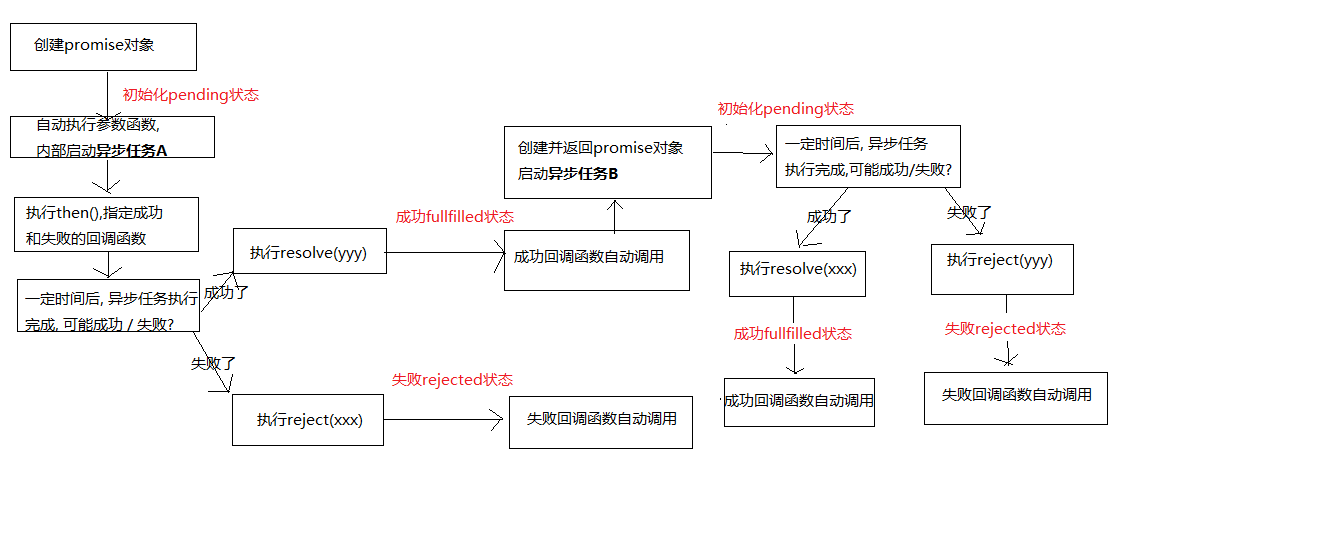Promise是什么
在MDN上是这样解释的:
- The Promise object is used for asynchronous computations.(Promise 对象用于异步计算)
- The Promise object represents the eventual completion (or failure) of an asynchronous operation, and its resulting value.(Promise 对象用于表示一个异步操作的最终状态(完成或失败),以及其返回的值。)
看完上面的解释你可能还是不太明白,我个人来理解,按照用途可以这样解释:
- 主要用于异步计算
- 可以将异步操作队列化,按照期望的顺序执行,返回符合预期的结果
- 可以在对象之间传递和操作 Promise ,帮助我们处理队列
异步回调存在的问题
我们在使用js做开发的时候,存在非常多的异步操作,而异步回调也是家常便饭,而在异步回调中存在着四个问题:
- 嵌套层很深,难以维护
- 无法正常使用reutrn 和 throw
- 无法正常检索堆栈信息
- 多个回调之间难以建立联系
Promise 简介
直接上代码解释:
1 | new Promise( |
以上就是 Promise 的语法,可以看出:
- Promise 是一个代理对象,它和原先要进行的操作并无关系
- 它通过引入一个回调,来避免更多的回调
Promise有三个状态:
- pending,待定,初始状态
- fulfilled,实现,成功状态
- reject,被否决,失败状态
当 Promise 状态发生改变,就会触发 .then() 里的响应函数处理后续步骤;此外,Promise 的状态一经改变,是不会再改变的。

如图,在 Promise 中,每一个 then() 都会返回一个新的 Promise ,这样就由 then() 的调用生产一个 Promise 的调用队列,根据执行结果的状态,不断的调用 then() 里面对应的处理函数,一个 then() 处理完后,继续下一个,直到所有的处理函数执行完毕。
使用promise基本步骤(2步):
- 创建promise对象
1 | let promise = new Promise((resolve, reject) => { |
调用promise的then():
1 | promise.then(function( |
promise 的基本使用
1 | //基本使用 |
1 | // 统一捕获异常 |
1 | //多个串联,第一个加载完后加载第二个,以此类推 |
1 | //promise.all 接收一个 promise 对象的数组 |
实际应用
promise 用的最广泛的地方在两个:
- 使用promise实现超时处理
- 使用promise封装处理ajax请求
1 | let request = new XMLHttpRequest(); |
来看看 promise 的执行顺序:
1 | //创建一个promise实例对象 |
执行结果:1111 => 2222 => 3333 => 失败了xxxx(成功了。。。atguigu.com)
可以用下图表示执行过程:

完整使用案例:
1 | //定义一个请求news的方法 |
运行代码后你会发现:
第一个promise如果成功,返回的是一个 promise,那么第二个 then 则看这个 promise 的结果。由于当前本地没有开启服务器接口,所以你第一个是错误的 reject('请求失败了。。。'),那么第二个 then 看的就是第一个 then 中 error 函数的返回,你只 alert,默认函数返回不是返回一个promise 对象,所以第二个 then 在你第一个 promise 进去错误的情况下,肯定是会执行的,并且 comments 为 undefined。
总的来说:promise 在 then 之后的后继的 then 都是看前面的 then 中执行的那个函数的结果来进行相应的操作,基本就两个,返回不是 promise 类型的,和是 promise 类型的,如果是 promise 类型的,则这个 then 就是基本的 then 操作,如果不是,那应该就是简单的带参回调函数。
注意:如果忽略针对某个状态的回调函数参数,或者提供非函数 (nonfunction) 参数,那么 then 方法将会丢失关于该状态的回调函数信息,但是并不会产生错误。如果调用 then 的 Promise 的状态(fulfillment 或 rejection)发生改变,但是 then 中并没有关于这种状态的回调函数,那么 then 将创建一个没有经过回调函数处理的新 Promise 对象,这个新 Promise 只是简单地接受调用这个 then 的原 Promise 的终态作为它的终态。
并且:如果then中的回调函数返回一个值,那么then返回的Promise将会成为接受状态,并且将返回的值作为接受状态的回调函数的参数值。
具体请参考: Promise.prototype.then()
完~